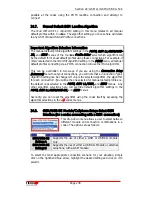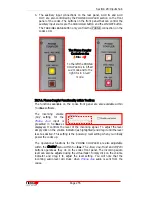
Section 25: ISDN Tab
T
ieline
Page 244
T E C H N O L O G Y
However, ISDN also supports point-to-multipoint configurations, with multiple
and dissimilar devices connected to a single line. In many cases, it is not
desirable to share the same directory number and Service Profile. Consequently
ISDN relies on an initialization procedure for associating Service Profiles with
individual terminating equipment, rather than lines. Terminating equipment that
supports this procedure is said to be Auto-Initializing.
The ISDN supplier gives the customer a Service Profile ID (SPID) of up to 20
digits long. The customer programs the number into the terminating equipment
which sends it to the switch. The switch then associates the SPID with a specific
Service Profile and Directory number. When the switch sends setup messages to
a point-to-multipoint line, only equipment with the matching SPID will respond.
25.6.
SPID1, SPID2 (Service Profile ID)
Users outside North America please leave the SPID1 and SPID2 blank. North
American users need to get SPID (Service profile ID) numbers from the phone
company and enter them exactly as supplied.
Some ISDN lines use two SPIDs, some one and some use none at all. If your
line was configured for two SPIDs, you must enter the appropriate numbers
exactly as they have been given to you by the phone company into the
SPID1
and
SPID2
boxes in the
ISDN
menu within
Tool
Box
. If your line has only one
SPID, program that number into both the
SPID 1
and
SPID 2
boxes. If you
have ordered service on only one B channel (1B+D), enter the SPID number into
SPID 1
and leave
SPID 2
blank. Finally, if your line has no SPIDs, verify that
there are no numbers programmed into
SPID 1
and
SPID 2
.
The phone company should provide this number exactly as it is to be entered. In
many cases however, a Terminal IDentifier (TID) is required at the end of the
SPID (usually 00 ,01, or 11) and the phone company will neglect to mention this.
If your switch type is an AT&T 5ESS custom point-to-point, you may need to
leave both
SPIDs
blank - even though they have been provided by the phone
company.
25.7.
DN1, DN2 and MSN Numbers
(Directory Numbers and Multiple Subscriber Numbers)
A Directory Number is the ISDN number assigned to each B channel of an ISDN
line. In North America users must get DNs from the phone company. These
must be entered exactly as provided. For most other locations, the Telco will
allocate MSN numbers to be used when more than one unit is on the line.
A Cautionary Note:
In
Tool
Box
you usually need to enter
DN
s with area code
(10 digits), while some other ISDN devices may only require 7 digits numbers. If
your switch type is an AT&T 5ESS custom point-to-point, you may need to leave
both
DN
s blank - even though they have been provided by the phone company.
















































